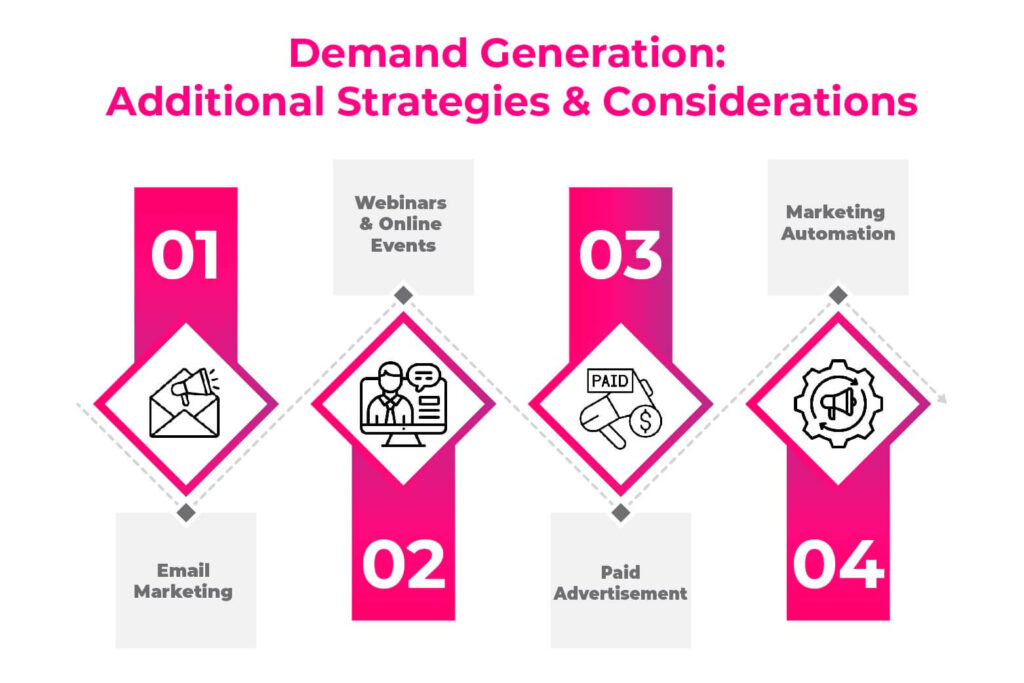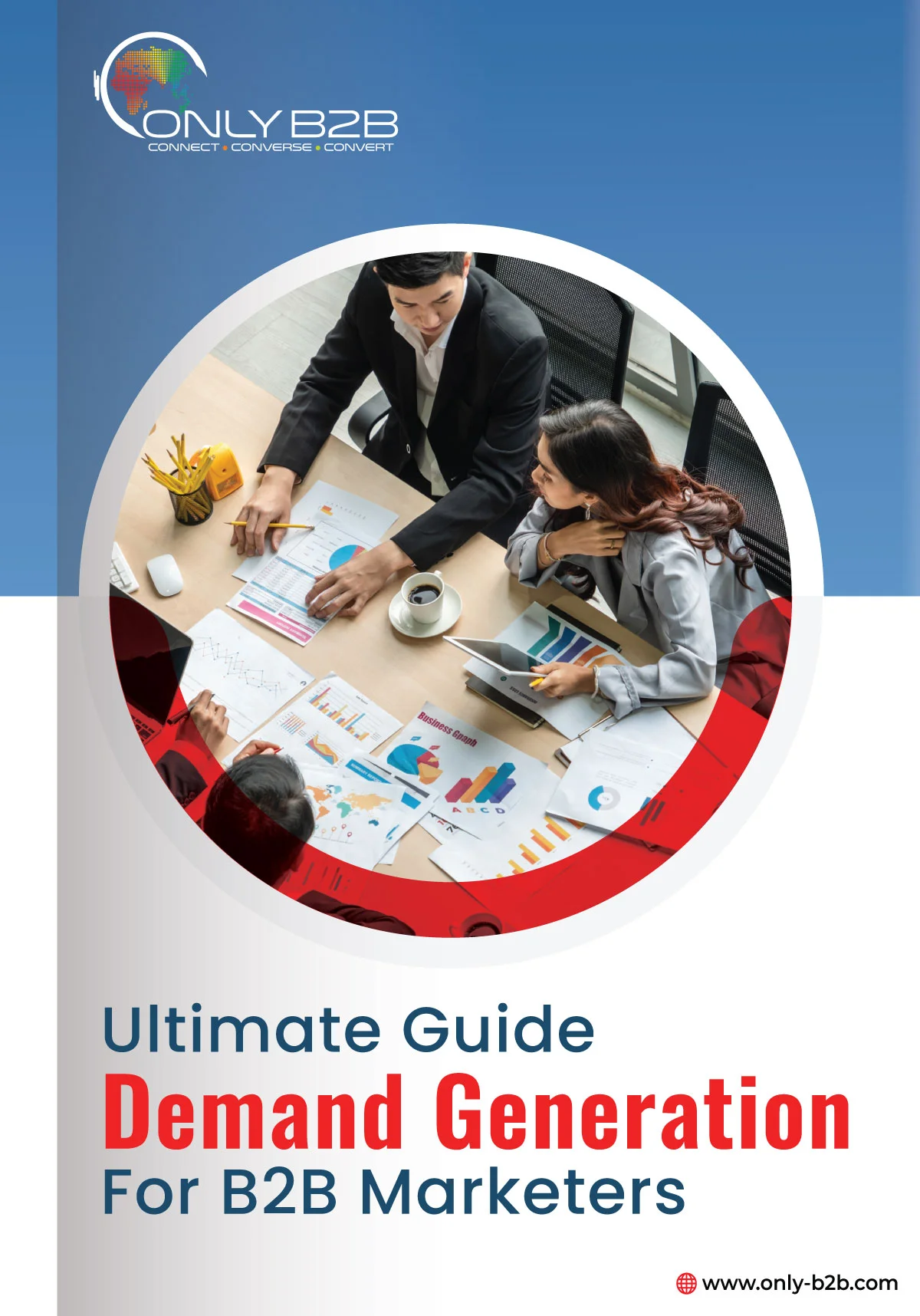
75% of B2B marketers are now focusing their demand generation tactics on customer retention and enrichment, a significant increase from previous years, emphasizing the need to include existing customers in demand generation strategies.”
– Forrester
Demand generation isn’t about forcing or tricking people into buying products or services. It’s about offering genuine information to the right people at the right time.
In other words, B2B demand generation helps your business stand out in the crowded market, educating potential buyers about how your products or services can benefit them.
It’s the best way to build brand awareness while highlighting needs that potential customers may not have considered.
Must Read: Top 6 Demand Generation Strategies Which Work!
What’s the Core B2B Demand Generation Strategies?
Table of Contents

1. Content Marketing
Creating valuable and fresh content is the cornerstone of any demand generation strategy. It’s a great way to attract your audience to your website and build brand awareness.
Above all, it’s the most reliable way to move users ahead in the buying journey.
And if your goal is merely to create awareness, you need to correct your approach. Instead, you should focus on building trust and positioning your brand as the go-to solution.
According to MarketingProfs, 87% of B2B marketers consider demand generation their top priority, highlighting the critical role of content in engaging audiences and driving demand.
Effective content marketing includes:
- Blog Posts: Regularly updated blogs keep your audience engaged and improve SEO.
- Whitepapers and Ebooks: These resources provide in-depth insights and establish authority.
- Case Studies: Demonstrating success stories helps build trust with potential clients.
A robust and efficient content strategy goes beyond blog posts or social media followings. You need to integrate all marketing efforts to make people want your product or service. This also means solving a problem—one that your prospect is currently struggling with or one they haven’t yet realized.
Read this insightful article about B2B demand generation statistics
2. Search Engine Optimization (SEO)
McKinsey reports that companies with effective SEO strategies can generate 50% more leads at a 33% lower cost per lead.
SEO and inbound marketing often target high-value TOFU (top-of-funnel) keywords. It’s equally important to create quality content pieces that attract and convert high-quality leads. This blend of craft and science involves having unique content alongside SEO practices.
Winning SEO strategies include:
- Keyword Research: Identify and use relevant keywords and target long-tail keywords for your products or services.
- On-Page SEO: Optimize your titles, meta descriptions, and content structure.
- Link Building: Acquire backlinks from reputable sources to enhance domain authority.
Must Read: B2B Content Ideas to Boost Demand Generation
3. Social Media Marketing
Social media is a great way to understand the demands and interests of your target audience. It allows businesses to connect and engage with prospects in unique and personalized ways.
Social media platforms are powerful tools for B2B demand generation, each offering unique advantages:
- LinkedIn: Ideal for B2B marketing, allowing you to share professional content and connect with industry leaders.
- Twitter: Use for quick updates, industry news, and relevant conversations.
- Facebook: Leverage Facebook Groups and targeted ads for niche B2B markets.
According to LinkedIn, 92% of B2B marketers include LinkedIn in their digital marketing mix, making it a valuable platform for demand generation.
Above all fostering trust is a key part of demand generation, as digital audiences look for transparency and authenticity on social media.
4. Public Relations (PR)
Understanding your buyers and their journey will help you learn more about their actions, such as the websites, industries, or publications they turn to when making buying decisions.
An intelligent public relations strategy complements the buying strategy by creating buzz, building trust, and reaching a wider audience than content strategy alone.
PR strategies must include:
- Press Releases: Announce significant milestones and product launches.
- Media Outreach: Build relationships with journalists and industry publications.
- Thought Leadership: Position your executives as thought leaders through guest posts, interviews, and speaking engagements.
5. Account-Based Marketing (ABM)
Forrester Research indicates that 92% of B2B marketers believe ABM is crucial for their overall marketing strategies.
Account-based marketing allows you to craft personalized campaigns tailored to account needs and characteristics.
By using CRM data, you can draft specific messaging for your targeted leads or groups of leads. While general messaging will not work for someone down the funnel; instead, tailor messaging to potential customers to lead them to conversion.
This tactic involves:
- Personalized Content: Tailor your content to address the unique needs of each account.
- Multi-Channel Outreach: Use a combination of email, social media, and direct mail to a.
- Sales and Marketing Alignment: Ensure a cohesive approach and seamless handoff of leads.Checkout these sales best practices.
Must Read: Account Based Marketing – An Important Aspect Of Demand Generation Channel
Additional Strategies & Considerations

1. Email Marketing
Email marketing should include opt-in emails or follow-up emails. Salesforce reports that personalized email subject lines can increase open rates by 26%. To maximize effectiveness:
- Segmentation: Divide your email list into segments based on industry, job role, and behavior.
- Personalization: Use personalized greetings and tailor content to the recipient’s interests.
- Automation: Implement automated workflows to nurture leads through the sales funnel.
Automate opt-in emails and follow-up emails for focused leads. Send white papers, infographics, and other types of content to highly focused leads.
Must Read: 5 Common B2B Demand Generation Pitfalls to Avoid
2. Webinars & Online Events
Webinars and online events are excellent for engaging with your audience in real-time. Participating in trade shows, hosting webinars, and organizing events are best ways to generate qualified leads (sales qualified or marketing qualified).
Hosting webinar sessions allows you to delve into clients’ problems and offer relevant solutions. They provide a platform to:
- Educate: Share valuable insights on relevant topics.
- Interact: Allow attendees to ask questions and engage in discussions.
- Generate Leads: Collect contact information and follow up with attendees post-event.
Most importantly focus on showcasing why your product or service is in demand rather than just selling it.
3. Paid Advertisement
Paid advertising allows your content to reach a broad audience. You can use Google to encourage users to download assets, boost newsletter signups, or promote an eBook.
Since every click comes with a cost, it makes sense to place your content in front of people who are actively searching for your solution.
Therefore, it is vital that your advertising is relevant to your buyers’ intent; otherwise, you will end up losing money for every wrong click.
By ensuring relevance, you will be able to turn clicks into conversions.
4. Marketing Automation
Marketing automation is a key factor in the success, scalability, and efficiency of modern marketing efforts. It streamlines marketing processes using technology to create tailored experiences for both current and prospective customers.
It involves more than just sending timely emails; it delivers the right content to the right person at the right time.
This technology helps predict which leads are most likely to convert, sends timely follow-ups, and customizes marketing campaigns based on user behavior.
Example: A software company can use marketing automation to send product recommendations based on user behavior. If a lead downloads a whitepaper, the system can automatically schedule a sales call or send a follow-up email.
5. Measuring and Analysing Results
Among all marketing strategies, measuring demand generation metrics is the hardest because many of the metrics are qualitative, such as lead quality and engagements.
Nevertheless, demand generation strategies are the most important to track. By measuring demand generation, you can identify your most and least profitable channels. Focus on key factors such as money invested, revenue generated, and engagement levels.
Regularly measure and compare your sales funnel, observe lead behavior patterns, and analyze the paths leads take.
This approach helps refine strategies, optimize channels, and improve overall campaign effectiveness.
Relevant Data on B2B Demand Generation:
To set the stage for understanding the landscape of B2B demand generation in 2024, let’s delve into some relevant data and statistics:
- According to a study by Content Marketing Institute, 87% of B2B marketers consider demand generation as their top priority, emphasizing its significance in achieving marketing goals.
- HubSpot reports that companies with effective demand generation strategies can generate 50% more leads at a 33% lower cost per lead, showcasing the importance of adopting successful strategies.
- A survey by Demand Gen Report reveals that personalized content is considered highly effective by 75% of B2B buyers, indicating the need for personalized demand generation approaches.
- Research by SiriusDecisions highlights that organizations with aligned sales and marketing teams experience a 24% faster three-year revenue growth and a 27% faster three-year profit growth.
- According to LinkedIn, 92% of B2B marketers include LinkedIn in their digital marketing mix, making it a valuable platform for B2B demand generation.
- The Content Marketing Institute states that 70% of B2B marketers are investing in content marketing for demand generation purposes, highlighting its effectiveness in engaging audiences.
- A study by InsideSales.com reveals that 35-50% of sales go to the vendor that responds first, emphasizing the importance of prompt lead follow-up in demand generation efforts.
- Salesforce reports that personalized email subject lines can increase open rates by 26%, demonstrating the impact of personalization on demand generation campaigns.
- According to Forrester Research, 92% of B2B marketers believe that ABM (Account-Based Marketing) is crucial for their overall marketing strategies, making it a powerful approach for demand generation.
- A study by Marketo shows that companies that excel at lead nurturing generate 50% more sales-ready leads at a 33% lower cost, highlighting the significance of nurturing in demand generation.
To Wrap Up
Demand generation is rapidly emerging as a key component in B2B marketing strategies. But it’s hard to organize and align all initiatives to ensure they are effectively driving demand
So why not make this easier? Simplify your demand generation efforts and ensure success by partnering with experts. If you need assistance, contact us today.

Vikas Bhatt is the Co-Founder of ONLY B2B, a premium B2B lead generation company that specializes in helping businesses achieve their growth objectives through targeted marketing & sales campaigns. With 10+ years of experience in the industry, Vikas has a deep understanding of the challenges faced by businesses today and has developed a unique approach to lead generation that has helped clients across a range of industries around the globe. As a thought leader in the B2B marketing community, ONLY B2B specializes in demand generation, content syndication, database services and more.


